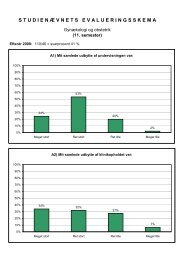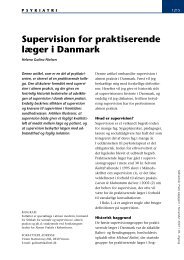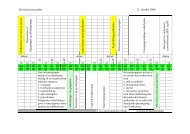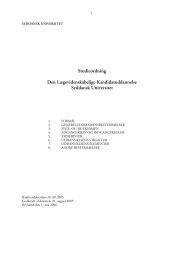shared deliberate practice
shared deliberate practice
shared deliberate practice
You also want an ePaper? Increase the reach of your titles
YUMPU automatically turns print PDFs into web optimized ePapers that Google loves.
Shared Deliberate Practice 217As a further argument why interviews as verbal recalls with athletes is a valid means ofinquiring into how they learned we will cite the argument by Helsen, Starkes and Hodges(1998) that expert athletes have eased recall because daily training is such an ingrained part oftheir daily routine.RESULTS AND DISCUSSIONThe purpose of the study was to identify and describe the relevant training situationspertaining to high performance handball team training, and to examine how the handballplayers’ development of expertise depends upon <strong>shared</strong> <strong>deliberate</strong> <strong>practice</strong>.The data analysis identified what characterizes <strong>shared</strong> <strong>deliberate</strong> <strong>practice</strong> in a highperformance team. First we describe two different types of training situations: structuredtactical training and match training. Second we investigate the <strong>shared</strong> <strong>deliberate</strong> <strong>practice</strong>characteristics as they pertain to the team training.Structured Tactical TrainingIn the tactical meetings the coach lays out the tactics that the team must follow in the nextgame. Often the coach uses video to illustrate the preferred play formation, tactics and habitsthe opposing team has exhibited in past games. The next step is to explain how the teamshould respond to these action tendencies of the opposing team. In the structured tacticaltraining the coach makes radical adjustments to the game plan for instance he decides that thegame score does not count in order to get the players to work with a few specific tacticalsystems as part of <strong>deliberate</strong> <strong>practice</strong>.In this type of training the coach often freezes the game so that the players remain ineither defensive or offensive formations.These adjusted game situations are repeated several times in order for the players toadjust their team tasks and team roles. As part of this <strong>shared</strong> <strong>deliberate</strong> <strong>practice</strong>, the coachrepeatedly interrupts the training activity and evaluates the players’ performances accordingto how well they align or conform to the tactical system. The coach’s evaluation is aimed atboth the team and individual players.These training activities fit Ericsson’s description of <strong>deliberate</strong> <strong>practice</strong> in so far as theyare designed and monitored by the coach, are structured and aimed at explicit well-definedtasks, and aim to improve team and individual performance. The coach aims that <strong>deliberate</strong><strong>practice</strong> target the team’s strengths and weaknesses in order to match or rather overmatch theweaknesses of the upcoming opponent team that they are playing next. In these trainingactivities, the coach has considerable influence on defining the critical aspects that theindividual players have to be aware of and work with in order to improve the team’sperformance. However, in the research interviews Mette and Katrine stress that tactics shouldbe a team matter and not only an individual task, even though the coach addresses tactics asthe responsibility of the individual player. Both players warnthat the team can sometimesoverlook the importance of being critical towards the intended tactics. Mette describes asituation from a match in which a player had a good opportunity to attack and score, but didnot seize this opportunity.
















